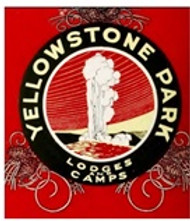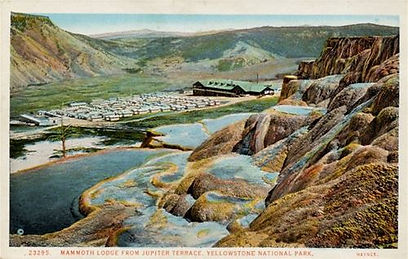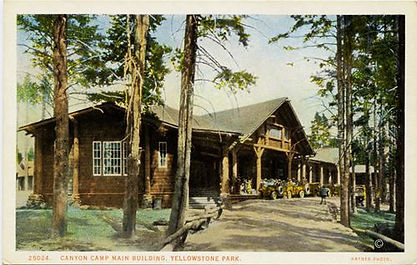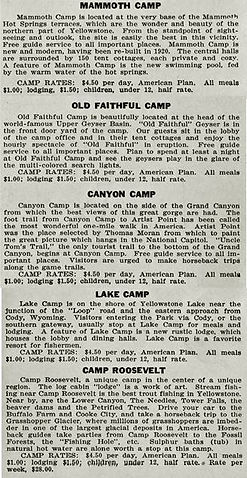

Camping in the Yellowstone
Yellowstone Park Camping Company - 1917-1919
Yellowstone Park Camps Company - 1919-1927
Yellowstone Park Lodge & Camps Company - 1927-1936
Copyright 2020 by Robert V. Goss. All rights reserved. No part of this work may be reproduced or utilized in any form by any means, electronic or mechanical, including photocopying, recording or by an information storage and retrieval system without permission in writing from the author.

Yellowstone Park Camping Company - 1917-1919
Huge changes were enacted in Yellowstone beginning with the 1917 season when the new National Park Service mandated a concessions consolidation plan. All of the stagecoaches were retired, and replaced with automobiles stages manufactured by the White Motor Co. All transportation would be run by H.W. Child and his Yellowstone Park Transportation Co. The various smaller camping companies were shut down, and the largest - the Shaw & Powell Camping Co. and the Wylie Permanent Camping Co. were combined into one company. This was known as the Yellowstone Park Camping Co. The hotels were mostly unaffected, except that the Fountain and Norris hotels were shut down as unnecessary due to faster travel time in the new auto stages. The general stores were untouched, but Frank Haynes was forced to sell his transportation operation and former stock in the Wylie Co., leaving him in control of the picture shops in Yellowstone.
Left: Possibly the 1st newspaper ad for the new Yellowstone Park Camping Co., 22Jun1917, Salt Lake Tribune.
Right: Newspaper ads with the new, "The Camp Way" logo showed up early in the summer of 1917. 3Aug1917, Salt Lake Tribune.
A.W. Miles gained 51% of stock in the new camping company, while various Shaw and Powell family members shared the remainder. Many of the former camps were abandoned to avoid duplication of services and a new camp at Mammoth was established. Camps located at Canyon, Lake, Riverside, Tower and Upper Geyser basin were retained, while camps at West Thumb, Willow Park, Gibbon Falls, Nez Perce, and the east entrance (Cody Camp) were abandoned. Riverside Camp closed in 1918 due to WWI and never reopened.
The company immediately began using the slogan "The Camp Way," a take-off of the Wylie Way motto. The logo itself was reminiscent of the Shaw & Powell logo. The term Camp Way continued to be used in advertising up into the early 1930s. By 1927-28, most of the permanent camps were beginning to be called lodges instead of camps. The “Wylie Way” slogan was no longer used in Yellowstone, but went into use in 1917 at Zion national Park, where Wm. W. Wylie opened up a new camp - the first lodgings in Zion.

Photo of a Yellowstone Park Camping Co. truck hauling employees to a camp in Yellowstone for the summer season.
A blurb in one of the company’s brochure boasted,
"A hostess at each camp look after the comfort and convenience of women guests. The camp atmosphere is clean, informal and pleasurable. There is nothing rough or coarse. There is no “dressing up.” The employees are young folk from private homes—many of them students and teachers. All sleeping tents are framed, floored, wainscoted and heated. The furnishings, while simple, are absolutely comfortable The beds are of the best quality, full sized. A special nightly feature at each camp is the "Camp Fire" and entertainment and dancing in the recreation pavilion. “Camp Roosevelt” is an extra “stop-over" camp for guests who desire to prolong the standard “four and one-half day tour." The government urges prospective visitors to plan if possible, to stay several extra days in the Park. The weekly .rate, American plan, is $30.00."

From The Yellowstone News, Spring 1918, published by the Yellowstone Park Camping Co.,
New method to revitalize your weary bones:
“Are you a member of that annual band of tired business men and women, fagged-out teachers and weary hosts and hostesses, worn by the strainn of a hard social season who are looking, during the summer time, for the road which leads to the three “R’s”—Rest. Recreation, and Recreation? . . .
You have "nerves?” Can't sleep nights? Then why hesitate longer? Pack your suitcase with a few warm, rough clothes and some stout shoes, wire the Yellowstone Park Camping Company to reserve accommodations for you. and take the first train to Yellowstone National Park, I wager the first morning’sride will smooth the wrinkles from your brow and soothe your tortured nerves; and after your first night’s rest you will awaken feeling reborn and ready for anything.”
Yellowstone Park Camps Company - 1919-1927
Howard Hays and Roe Emery purchased the YP Camping Co. in 1919. Walter White of the White Motor Co. was a silent partner and Hays became president of the company. Harry Child, wanting to buy the company very badly, after having to give up his share of the Wylie Co. after 1916, was hoping to get a good deal. While he was waiting for the $150,000 price to come down, Hays unexpectedly came up with the money, with backing by White. Walter White hid his involvement in the business, as he did not want to antagonize Child, who was one of his large customers for White buses.
The new owners expanded operations of the camps by building rustic log lodges and recreation halls at all existing locations except Riverside, which closed in 1918 due to WWI and never reopened. A swimming pool was built at Mammoth Lodge around 1920 and a Boys Forest & Trail Camp was established at Roosevelt in 1921 that included a swimming pool, council house, and eight tent cabins. The camp taught boys the fine arts of fishing, mountain climbing, and studying the flora and fauna.

For additional information and photos of these camps & lodges, check my "Hotels" web pages: Mammoth; Roosevelt; Canyon; Lake; Old Faithful.

Above: Camp photos from the YP Camps Co. 1922 brochure..
Right: Description of the five camps, from a 1920 YP Camps Co. brochure.


From the Director of the NPS, Stephen T. Mather, in his 1924 annual report
Vernon Goodwin takes over the helm of the YP Camps Co.
The company was sold in 1924 to Vernon Goodwin of Los Angeles, when Howard Hays retired and sold out due to poor health. The Salt Lake Tribune of May 9, 1924 explains:
“The Yellowstone Park Camps Company, controlling the camp system in the national playground, has been sold to Vernon Goodwin, wealthy Los Angeles hotel man, according to an announcement received yesterday 'by Daniel S. Spencer, general passenger agent for the Oregon Short Line railroad, from Horace M. Albright, superintendent of Yellowstone park. The consideration was not made public.
The property has been controlled by Howard H. Hays, formerly of Salt Lake, and the sale has the approval of S.T. Mather, director of the national parks service, who recently joined with Mr. Albrlght, Mr. Hays and the purchaser in a discussion of the deal in Los Angeles.
All officers of the company, with the exception of Mr. Hays, will remain with the organization, it is understood. The sale of the properties was prompted by the ill health of Mr. Hays, who is preparing, on the advice of a physician, for a rest of about six months.”
Harry Child kept his involvement in the new company quiet, much as White had done five years earlier. The purchase now cost Child four times what it would cost him in 1919. Goodwin became company President and A.L. Smith served as Secretary/Treasurer. Ed Moorman, who had previously served as Secretary/Treasurer was brought into the deal and became Manager. The company opened the Sylvan Pass Lodge in 1924, located near the East Entrance. The lodge, along the route from Cody to Lake Hotel, provided meals in a log lodge and guests could stay overnight in tent facilities. The lodge operated for ten years.
Vernon Goodwin, who had been manager of the Alexandria and Ambassador hotels in Los Angeles, purchased the YP Camps Co. in 1924 for $660,000 with financing by Harry Child. Although it technically became known as the Vernon Goodwin Co. the company continued to be referred to as the YP Camps Co. According to "Greater Los Angeles & Southern California Portraits & Personal Memoranda," Lewis Publishing Company, 1910.
Goodwin was "born in Santa Rosa, Cal., Dec. 13, 1871. Chiefly educated in public and high schools. Assistant postmaster of Santa Rosa for three years; resigned to take a law course, and admitted to practice in California Supreme Court, 1894. Principal of grammar school for three years, and later took a special English course at Stanford University. Served as Deputy County Auditor for four years and resigned to accept position with California Gas & Electric Corporation. Came to Los Angeles, 1895; now Secretary of the Bilicke-Rowan Fireproof Building Co., Bilicke-Rowan Annex Co., Alexandria Hotel Co. and Hollenbeck Hotel Co."
[Rotarian Magazine, March 1926]
The Yellowstone Park Lodge & Camps Co.
This company came into existence sometime in 1927 when Vernon Goodwin Co. changed the name. When Goodwin’s wife died in January 1927, her obit mention Vernon being President of the Yellowstone Park Lodge & Camps Co. The company continued the operation of lodges and camps at Old Faithful, Lake, Canyon, Fishing Bridge, West Thumb, Mammoth, and Roosevelt. Although the name changed, Goodwin remained in management with the Child enterprises and was listed as president of the YPLC Co while Ed Moorman was retained as general manager. This new company (just in name) invested $300,000 on new buildings at Canyon, Lake and Old Faithful. Cafeterias were also built at the public auto camps at Old Faithful and West Thumb. The trend now was to focus on a lodge operation as opposed to tent facilities. Gradually the historic striped canvas sides and tops were replaced with more conventional wood structures. When Harry Child died in 1931, his son-in-law Wm. Nichols took over the operation and Goodwin became vice president of the YP Hotel Co. The company struggled during the Depression, as did the hotel andother park businesses. Some camps closed for a year or more, but that the camps were less expensive than the hotels was a distinct advantage.


For additional information and photos of these camps & lodges, check my "Hotels" web pages: Mammoth; Roosevelt; Canyon; Lake; Old Faithful.

Advertising from the company's 1930 brochure:
"From many years' experience, the Yellowstone Park Lodge and Camps Company has developed a truly remarkable system and service. The Lodges are located at the main centers of scenic interest. In each lodge, guests come first to a great central building, which house lobbies, dining halls, social assembly rooms, business headquarters, curio shops and many of the usual facilities of hotels and clubs. Surrounding the main buildings are the small lodges—of one-room, two-room and four-room capacity. They are of two types - (1.) log, (2.) rustic clap board - all substantially built, comfortable and well furnished. Each lodge is heated by a rustic wood-burning stove (for nights and mornings are cool in the mountains), the beds are full size and of high quality, the furniture plain but adequate. Lodges are electric lighted, of course. The dining rooms serve wholesome, well-cooked food."

Yellowstone Park Company - 1936-1979
In 1936 the Yellowstone Park Lodges & Camps Co. merged together with the other Child-Nichols interests into the Yellowstone Park Company. These interests included the Yellowstone Park Hotel Co., Yellowstone Park Transportation Co., and the Yellowstone Park Boat Co. Wm Nichols was president, Vernon Goodwin vice-president, and Mrs. Harry Child remained a principle stockholder. The company embarked on an ambitious renovation plan which including the razing of the Mammoth Hot Springs Hotel (Old National Hotel). The North Wing was retained and a new lobby/office complex constructed at the end of the wing. A separate restaurant, recreation hall, and cabins were also erected. Many of the tent cabins at Mammoth Lodge were moved to Roosevelt Lodge and the MHS Lodge was shut down in 1940. It was the beginning of a new era for the company in Yellowstone, but the earlier vision of the tent camp operation became a lost relic of history. The National Park Service's Mission 66 plan in the 1950s closed down the beautifully rustic camp at Canyon, and new facilities were constructed at Canyon Village, a mile or two away. Sylvan Closed around 1934, but Roosevelt Lodge, Lake Lodge, and Old Faithful Lodge remain successful operations to this day, under the auspices of Xanterra Parks & Lodges.



Top Left: Mammoth Lodge, 1923. Haynes Postcard #23295
Center: Old Faithful Lodge, 1928, Haynes Postcard #28029
Bottom Left: Lake Lodge, 1922.
Haynes Postcard #22032

Top Right: Roosevelt Lodge, 1927. Haynes Postcard #27468
Bottom Right: Canyon Lodge, 1922.
Haynes Postcard #22032
Of these five lodges, only Roosevelt, Lake & Old Faithful remain.





